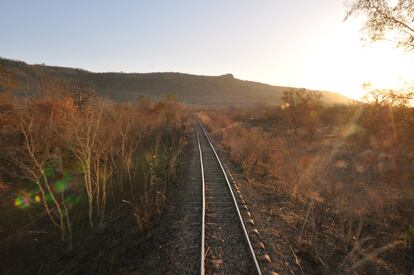Bamako- Dakar by train (1)

Fotos de roseskelton.co.uk
The train from Bamako to Dakar rumbles through the golden landscape of western Mali, carrying passengers from the Malian capital to towns and villages in the deep, dry countryside. Low trees and bushes edge the railway line and in the distance, rocky hills line the horizon. The countryside in this part of west Africa seems almost empty, except for long track which winds its way across 1233 kilometres of wide, open land, feeding the Malian hinterland, bringing people in and goods out, to the port in Dakar and to the world beyond. Without this frequent passenger service, which runs three times a week, villages in the Malian countryside would be all but cut off from the outside world.
"The train is like a village which moves," says Baba Kone, an inspector who patrols the second class carriage checking people have the right ticket. We climb over women, children and heaps of luggage, all piled up in the narrow passageway, to get from one end to the other of the carriage. "The people sitting in the gangways did not make seat reservations," he says, tapping on a bundle of goods which turns out to have a woman folded up with it. In this way, slowly, we make our way through the carriage.
"The life of this train is purely social," says his colleague, Moussa Marre Coulibaly, who has worked for Transrail, the company which runs the train, for twenty years. "The train allows people to see their families. At every station we open the doors and see who gets in and gets out. I am happy to work for my nation," he says proudly.
The Dakar-Niger railway, so-called because it connects the Senegalese capital with the River Niger in neighbouring Mali, was built by French colonisers and has been running since the beginning of the 20th century. In recent years it has become famous with travellers who (like this writer) have waited for up to a week to catch the train, so frequent are derailments and accidents along the track. Because of the poor state of the line, which is tended by mechanics who do their best to keep the track together, a passenger service runs now only between Bamako and Kayes, in western Mali. The rest of the track, through Senegal and to the port in Dakar, is just for goods like cotton and iron ore, for wagons which don't mind waiting for hours or days for the track to be fixed or the derailed carriages to be cleared up.
The cheminots, as railway workers are known in west Africa, are like a caste of people, the work handed down from father to son, sometimes for generations. Cheminots live and die on the railway line. But passengers, too, have an attachment to the line that seems to run in the blood.
"I was born on the rails," says Cheikh Traore, who is riding to see his family in Kayes, "and I have taken the train my whole life." He lists the problems the train is facing: accidents, bandits, and the constant lateness of the train's arrival. "Before, we used to leave Bamako at 7am and arrive in Kayes by 5pm," he says. "Now, we don't arrive in Kayes until midnight. The line is no good anymore, but if the road was good, the train wouldn't be full like this..." he sweeps his arm around the carriage. "But the train is no good anymore either," he says sadly.
At a small village just before Kayes, the train stops as night is falling. The low station buildings, made from red bricks in the colonial style, glow in the evening light. There is mayhem as passengers jump in and out of the carriages, and wooden carts line up to shove bags of grain and piles of firewood into the freight wagons. Some kids arrive on bicycles to meet the train and carry off the goods which have come from other towns. "This train gives a living to the villagers," says Sadio Dembele who has been riding the Dakar-Niger for 25 years. "Without it, they could not survive."
It is 2am when I am awoken from a deep sleep by the incredible sound of drums and singing voices crowing through a public address system. The train door slams open and Beca, a griot or praise singer, forces his way down the narrow passage way and into the carriage in which our delegation, senior members of Transrail, are dozing. Outside, women dressed in fine cloths and dramatic headwraps, holding microphone and accompanied by percussionists, sing the names of the delegation who have come to Kayes, a city built on the rails. Beca kneels before the Director General and bows his head to the floor, all the while singing his praises, and the praises of Transrail, without whom, this part of the world could not survive.
Nota: Los textos de los autores se publican en su versión original, primero y, más tarde, traducidos al castellano (cuando encontramos el momento de hacerlo o la ayuda de algún espontáneo). Gracias.
Tu suscripción se está usando en otro dispositivo
¿Quieres añadir otro usuario a tu suscripción?
Si continúas leyendo en este dispositivo, no se podrá leer en el otro.
FlechaTu suscripción se está usando en otro dispositivo y solo puedes acceder a EL PAÍS desde un dispositivo a la vez.
Si quieres compartir tu cuenta, cambia tu suscripción a la modalidad Premium, así podrás añadir otro usuario. Cada uno accederá con su propia cuenta de email, lo que os permitirá personalizar vuestra experiencia en EL PAÍS.
¿Tienes una suscripción de empresa? Accede aquí para contratar más cuentas.
En el caso de no saber quién está usando tu cuenta, te recomendamos cambiar tu contraseña aquí.
Si decides continuar compartiendo tu cuenta, este mensaje se mostrará en tu dispositivo y en el de la otra persona que está usando tu cuenta de forma indefinida, afectando a tu experiencia de lectura. Puedes consultar aquí los términos y condiciones de la suscripción digital.
Archivado En
Últimas noticias
Internet y las redes sociales es lo que más influye en las opiniones políticas, según el CIS
Víctimas de la dana y entidades sociales exigen de nuevo el acta de diputado a Mazón: “No vamos a dejar pasar página”
Madrid deja en blanco el listado de recursos para víctimas de violencia sexual sin denuncia
El PSOE desvincula al exalcalde de Linares (Jaén) de una acusación de acoso sexual
Lo más visto
- Lotería de Navidad 2025 | 79432, el primer premio de la Lotería de Navidad
- Comprobar Lotería de Navidad 2025: consulta la pedrea con la lista de números premiados
- El Gobierno y Bildu acuerdan extender a 2026 la prohibición de desahuciar a personas vulnerables
- El PP de Almeida vota en contra de dedicarle a Robe Iniesta un centro juvenil porque antes quiere hablarlo con su familia
- Europa presiona a Ucrania para que contenga el éxodo de jóvenes hacia los países vecinos
































































